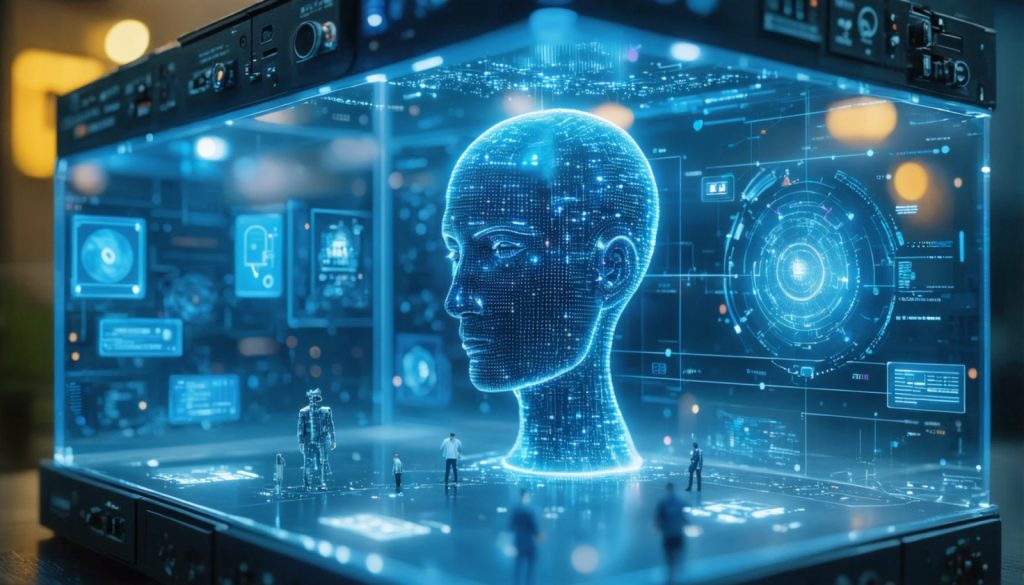
- A dedicated team in Kochi developed India’s first fully-designed AI server, named the Rudra-3 AI server.
- This server is part of the next-generation supercomputer, Param, unveiled in Manesar.
- The project was praised by Ashwini Vaishnaw, Union Minister for Electronics and Information Technology, as “fantastic” or “Adipoli” in Malayalam.
- The Rudra-3 AI server features eight GPUs and is expected to advance supercomputing in areas like weather forecasting, disaster management, research, and medical technology.
- India has transformed its electronic manufacturing landscape, with massive revenue growth and exports increasing sixfold over the past decade.
- VVDN Technologies’ new facilities in Manesar underscore India’s rise as a global tech competitor.
- This achievement signifies India’s burgeoning expertise in homegrown tech innovation and manufacturing.
In the bustling tech hub of Kochi, nestled along the serene backwaters of Kerala, a group of dedicated engineers achieved a groundbreaking feat. They contributed significantly to creating India’s first fully-designed artificial intelligence server. This was not just another addition to the long list of tech triumphs but a testament to Kerala’s remarkable ascendancy in the national tech arena.
The server, an engineering marvel called the Rudra-3 AI server, forms a crucial part of India’s next-generation supercomputer known as Param. It stands as a beacon of innovation in Manesar, unveiled to the public amid palpable excitement. Unlike any ordinary tech launch, this unveiling was graced by none other than Ashwini Vaishnaw, the Union Minister for Electronics and Information Technology. His spirited praise of this technological leap, captured through the lens of social media, was encapsulated in a single Malayalam word, “Adipoli”—aptly translating to “fantastic.”
Crafted with precision, the eight-GPU AI server promises to redefine supercomputing. It is expected to make significant strides in realms like weather forecasting and disaster management. On a broader spectrum, its capabilities are likely to permeate through complex research fields such as thermodynamics and the ever-evolving domain of medical technology, pushing boundaries of what’s possible.
The creation of this AI server heralds a new chapter for Indian electronics. Once reliant on foreign expertise, the nation now boasts an impressive track record in homegrown design and manufacturing excellence. Over the past six years, India’s electronic manufacturing landscape has transformed, with revenues soaring to an astonishing Rs 11 lakh crore. Exports too, have surged dramatically, marking a sixfold increase over the past decade. This meteoric rise underscores a core message: India’s burgeoning potential in creating sophisticated electronic products is undeniable.
Furthermore, Vaishnaw’s inauguration of VVDN Technologies’ state-of-the-art facilities in Manesar highlighted the synergy of ingenuity and manufacturing might. With an eye on future prospects, this development embodies India’s transition to a tech powerhouse capable of competing on a global stage.
This formidable achievement by the team in Kochi is more than just a technological advancement. It is a testament to the neural network of talent pulsating through India’s tech landscape, driving the nation toward uncharted territories ripe with opportunity. In a world where innovation is the pulse of progress, India’s edge is now sharper than ever, crafted meticulously by the hands that continue to define its digital destiny.
Unveiling the Future: Inside India’s Revolutionary AI Server and Its Implications on Tech Landscape
Understanding the Rudra-3 AI Server
The Rudra-3 AI server represents a significant leap in India’s technological capabilities, marking a pivotal development in the field of artificial intelligence. As part of India’s next-generation supercomputer, Param, the Rudra-3 stands as a symbol of India’s growing prowess in tech innovation.
Key Features of the Rudra-3
– Eight-GPU Architecture: The server boasts an impressive eight-GPU configuration, enhancing its computational power and efficiency.
– Integration with Param Supercomputer: Rudra-3 plays a crucial role in Param, offering robust AI-driven capabilities across diverse applications.
Real-World Applications
The server’s deployment is set to drive substantial advancements in various fields:
1. Weather Forecasting: Enhanced data processing speeds enable more accurate and timely weather predictions.
2. Disaster Management: AI-driven insights can improve disaster prediction and response strategies.
3. Medical Technology: Provides advanced computational power for research in medical imaging and diagnostics.
4. Thermodynamics and Complex Research: Facilitates groundbreaking research through high-performance computing.
The Rise of Indian Electronics
India’s journey from being heavily reliant on foreign expertise to becoming a frontrunner in tech design and manufacturing has been remarkable:
– Revenue Growth: India’s electronic manufacturing industry has seen revenues soar to Rs 11 lakh crore over the past six years.
– Export Growth: A sixfold increase in exports over the past decade highlights India’s rapid expansion in the global electronics market.
Insights & Predictions
Experts foresee a continuing rise in India’s tech capabilities, with potential breakthroughs in AI and computing technology poised to bolster the country’s global standing. As India strengthens its foothold in electronics, its role as a major player in the global tech market is expected to expand significantly.
Tutorials & Compatibility: How to Harness Rudra-3
For researchers and tech enthusiasts looking to leverage the Rudra-3 AI server’s capabilities:
1. Understand the Architecture: Familiarize yourself with the eight-GPU setup to optimize usage.
2. Focus on Custom Applications: Engage in custom software development tailored for AI applications to maximize potential.
3. Leverage High-Performance Frameworks: Utilize frameworks that are compatible with GPU computing for effective implementation.
Pros & Cons Overview
Pros
– High Computational Power: Enables significant advancements in complex simulations and data processing.
– Enhancement of Domestic Tech Capability: Marks a step towards self-reliance in tech innovation and production.
Cons
– Initial Cost and Setup: Implementing such advanced technology involves substantial upfront investment.
– Skill Requirement: Requires expertise in AI and high-performance computing for effective application and maintenance.
Actionable Recommendations
– Collaborate with Academic Institutions: Partner with universities and research institutions to explore new applications and drive innovation.
– Invest in Skill Development: Develop specialized training programs to build expertise in operating and maintaining cutting-edge servers like Rudra-3.
– Foster Global Partnerships: Establish collaborations with global tech companies to drive mutual growth and innovation.
Controversies & Limitations
While the Rudra-3 AI server is an engineering marvel, it’s essential to consider potential limitations:
– Energy Consumption: High-performance servers require considerable energy resources, which could pose sustainability challenges.
– Data Security Risks: Handling sensitive data demands stringent security measures to thwart potential cybersecurity threats.
For more insights into India’s tech innovations, visit [India Tech News](https://india.gov.in/).
By investing in such high-tech developments, India continues to etch its mark on the world technology map, pushing the boundaries of what is possible.



